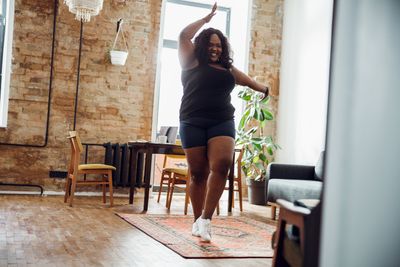Based on a recent post I did about exercise, many of us want to lift weights to keep our bones healthy and strong, but are either bored with it or can't find a way to fit it into our all-too-busy schedules.
To give us some answers, I mined the knowledge of fitness expert and author Joan Pagano. Joan, with 20-plus years of experience, is certified by the American College of Sports Medicine (ACSM) and really knows her stuff. She's here to share lots helpful advice on how you can achieve total fitness in less time.
Sheryl:Can you give us some tips on how to squeeze strength training into our schedules?
JOAN: With a little strategy, it's easy to do twice a week. A full-body weight training session should include a minimum of 8-10 exercises that work the major muscle groups (hips and thighs, back, chest, shoulders, arms and calves. Then there are the abdominals, too). REMEMBER THIS: Research shows that getting rid of belly fat has a real heart-health benefitand that exercise can reduce the negative effects of belly fat!
TO PUT IT SIMPLY -This is all you need: Just one set of 8-12 repetitions of each exercise is enough to develop strength – as long as the weight is heavy enough to make the last few repetitions challenging.
Sheryl: Is there an effective way to work a few muscles at a time?
JOAN: Absolutely. One of my favorite time-savers is to do multi-joint exercises that combine upper and lower body movements. GREAT EXAMPLES AHEAD! For instance, do a squat along with a biceps curl, a plie along with a shoulder raise and a lunge with a lat row. Just think – that's three leg exercises (which work the large muscles of the hips, thighs and buttocks) plus three upper-body exercises! If you add push ups for your chest, shoulders and triceps and a couple of core exercises, like pelvic tilts and crunches, you're done in just 15 minutes.
Sheryl: What if you need to sneak in a super-quick strength workout and can't get to a gym?
JOAN: Easy. If you combine squats and push-ups with your abs workout, you have a mini full-body conditioning routine that you can do any time, any place. HERE'S A DESCRIPTION: For a squat, stand in front of a sturdy chair with your feet parallel, hip-width apart; shift your weight back onto your heels. Bring your arms forward for balance, then bend your knees and reach back with your hips, lowering yourself toward the chair as if you were going to sit down. (If you are new to this exercise, just go partway down; otherwise, continue to bend your knees until you tap the edge of the chair with your hips. Squeeze your buttocks to return to the start position.)
Push-ups come in many variations; pick one that you can do for 10-15 repetitions. Make sure your hands are 3-4 inches wider than shoulder-width apart. Pull in your abs to keep your low back from sagging, and make sure your head and neck are aligned with your spine. Try the KITCHEN COUNTER PUSH-UP: With your hands on the counter, arms straight, step back until your body is on a diagonal. Keep your torso straight as you bend your elbows, lowering your chest toward the counter. Your heels will naturally lift up. To shift more body weight onto your upper body, stay up on your toes for the whole time.
Sheryl: Let's say I do yoga. Are the poses that are done enough to "count" toward strength training?
JOAN: Strength training exercises that use body weight alone share a lot with Yoga postures. For instance, Yoga's Sun Salutation sequence incorporates moves used in fitness training, like back extensions, planks, push-ups, lunges and squats. Yoga's Chairpose works the same muscles as a squat does. And the premise of "functional fitness" is just that: getting our muscles to function together in an integrated fashion, simulating movement patterns that reinforce the way we perform our daily activities.
Sheryl: Speaking of functional fitness, why are the core – or abdominal muscles – so important?
JOAN: The abs engage the minute you get out of bed, and continue to work all day long. HERE'S WHY YOU NEED STRONG ABS: A strong core equips you to handle the routine physical demands of daily life, like lifting children, working at a desk, doing housework, driving a car, or simply getting out of a chair.
Sheryl: Lastly, the question for the ages: how do you counteract the boredom that so many of us suffer through this process?
JOAN: The first step is to learn 8-10 exercises and establish a routine; then it's time to get creative and mix things up. The more variety you have in your repertoire, the more options you have and the better you can select a workout to suit your mood. WISH- YOU'D –KNOWN- THIS -SOONER TIPS: You can't do the same routine for more than a couple of months or your muscles will stop improving. When it's time to change, learn to use some new equipment, combine free weights with toning and medicine balls, stretch bands and tubes. Get a stability ball or a step platform. Do a DVD, take a class, try circuit or interval training. Keeping your routine fresh will also stimulate your brain!
For more in-depth information, look for Joan's books which include Strength Training for Women, 15-MinuteTotal Body Workout and 15-Minute Abs (the last two even come with a DVD).


